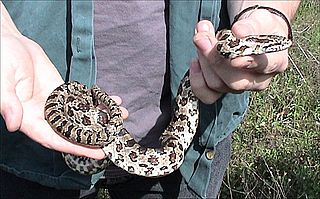
The milk snake or milksnake, is a species of kingsnake; 24 subspecies are currently recognized. Lampropeltis elapsoides, the scarlet kingsnake, was formerly classified as a 25th subspecies, but is now recognized as a distinct species. The subspecies have strikingly different appearances, and many of them have their own common names. Some authorities suggest that this species could be split into several separate species. They are not venomous to humans.

Kingsnakes are colubrid New World members of the genus Lampropeltis, which includes 26 species. Among these, about 45 subspecies are recognized. They are nonvenomous and ophiophagous in diet.

The California kingsnake is a nonvenomous colubrid snake endemic to the western United States and northern Mexico, and is found in a variety of habitats. Due to ease of care and a wide range of color variations, the California kingsnake is one of the most popular snakes in captivity.

The scarlet kingsnake or scarlet milk snake is a species of kingsnake found in the southeastern and eastern portions of the United States. Like all kingsnakes, they are nonvenomous. They are found in pine flatwoods, hydric hammocks, pine savannas, mesic pine-oak forests, prairies, cultivated fields, and a variety of suburban habitats; not unusually, people find scarlet kingsnakes in their swimming pools, especially during the spring. Until recently, and for much of the 20th century, scarlet kingsnakes were considered a subspecies of the milk snake; however, Pyron and Bubrink demonstrated the phylogenetic distinction of this species and its closer relationship to the mountain kingsnakes of the southwestern United States. These largely fossorial snakes are the smallest of all the species within the genus Lampropeltis, usually ranging from 40 to 50 cm at maturity. The maximum recorded length is in Jonesboro, AR 76.2 cm (30.0 in). Hatchlings range in size from 8 to 18 cm .

Coral snakes are a large group of elapid snakes that can be divided into two distinct groups, the Old World coral snakes and New World coral snakes. There are 16 species of Old World coral snakes, in three genera, and over 65 recognized species of New World coral snakes, in two genera. Genetic studies have found that the most basal lineages have origins in Asia, suggesting that the group originated in the Old World. While new world species of both genera are venomous, their bites are seldom lethal; only two confirmed fatalities have been documented in the past 100 years from the genus Micrurus. Meanwhile, snakes of the genus Micruroides have never caused a medically significant bite.

The gray-banded kingsnake, sometimes referred to as the alterna or the Davis Mountain king snake, is a species of nonvenomous snake in the family Colubridae. The species is endemic to the southwestern United States and adjacent Mexico. Some sources list two distinct subspecies of Lampropeltis alterna, as L. a. alterna and L. a. blairi differentiated by patterning and locale, but research has shown them to be color morphs of the same species.

The speckled kingsnake is a nonvenomous species of kingsnake. It is endemic to the United States.

Lampropeltis calligaster is a species of kingsnake known commonly as the prairie kingsnake or yellow-bellied kingsnake.

Cemophora coccinea copei, commonly known as the northern scarlet snake, is a subspecies of harmless colubrid snake that is native to the southern and eastern United States.
Frank Nelson Blanchard was an American herpetologist, and professor of zoology at the University of Michigan from which institution he received his Ph.D. He is credited with describing several new subspecies, including the broad-banded water snake, Nerodia fasciata confluens, and the Florida king snake, Lampropeltis getula floridana. As well, he has been honored by having reptiles and amphibians named after him, including the western smooth green snake, ecies | Opheodrys vernalis blanchardi, and Blanchard's cricket frog, Acris crepitans blanchardi.

Lampropeltis getula, commonly known as the eastern kingsnake, common kingsnake, or chain kingsnake, is a harmless colubrid species endemic to the United States and Mexico. It has long been a favorite among collectors. Nine subspecies are currently recognized, including the nominate subspecies described here.

The short-tailed snake is a small harmless colubrid snake. Fossorial and seldom seen, it is found only in sandy, upland parts of Florida where it is listed as Threatened and is protected by state law.

Lampropeltis rhombomaculata, commonly known as the mole kingsnake or the brown kingsnake, is a species of snake in the family Colubridae. It is a relatively medium-sized snake that occupies a variety of habitats from Baltimore, Maryland, south through the Florida Panhandle and west into Mississippi and Tennessee.

Cemophora coccinea coccinea, commonly known as the Florida scarlet snake, is the nominotypical subspecies of the scarlet snake. It is a nonvenomous colubrid snake that is endemic to the southeastern United States.
Caryospora is a genus of parasitic protozoa in the phylum Apicomplexa. The species in this genus infect birds and reptiles with the majority of described species infecting snakes. It is the third largest genus in the family Eimeriidae.

Lampropeltis getula floridana or the Florida kingsnake is a snake subspecies native to southern Florida. On average, they grow between 3.5–5 ft but 6 ft individuals have been recorded.

Lampropeltis mexicana, the Mexican kingsnake, is a colubrid snake that is endemic to Mexico.

Lampropeltis getula brooksi is a subspecies of nonvenomous snake in the family Colubridae. Lampropeltis getula brooksi is one of several subspecies of Lampropeltis getula.















